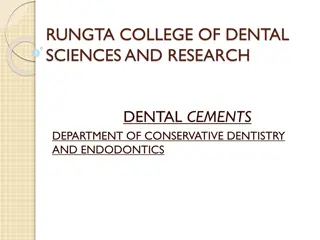Overview of Cement: Types, Composition, and Functions
Cement is a vital building material consisting of various compounds like lime, silica, and alumina. It is used in mortar and concrete. The chemical composition of cement includes elements like iron oxide and gypsum. Different types of cement serve specific purposes such as rapid hardening or sulfate resistance. Ordinary Portland Cement (O.P.C) has major constituents like lime and silica. The functions of cement in manufacturing are essential for construction projects.
Download Presentation

Please find below an Image/Link to download the presentation.
The content on the website is provided AS IS for your information and personal use only. It may not be sold, licensed, or shared on other websites without obtaining consent from the author. Download presentation by click this link. If you encounter any issues during the download, it is possible that the publisher has removed the file from their server.
E N D
Presentation Transcript
Cement: Cement is the mixture of calcareous, siliceous, argillaceous and other substances. Cement is used as a binding material in mortar, concrete, etc.
Chemical Composition of cement is: Lime Silica Alumina Iron oxide Gypsum 63% 22% 06% 03% 01 to 04%
Bogues Compounds C3S & C2S PRVIDE STRENTH & OFFERS RESISTANCE TOWARDS THE ATTACK OF ACIDS &ALKALIES. Name of Compound Formula Abbreviated Formula Tricalcium silicate 3 CaO.SiO2 C3S hydrates rapidly; provides early & ultimate strength Dicalcium silicate 2 CaO.SiO2 C2S-hydraes slowly& provides strength after a duration of 7 days Tricalcium aluminate 3 CaO.Al2O3 C3A-hydrates rapidly; provides early strength & less ultimate strength Tetracalcium aluminoferrite 4 CaO.Al2O3.Fe2O3 C4AF-doesn t provide strength but is stable than C3A
TYPES OF CEMENT: 1. Ordinary Portland Cement 2. Rapid Hardening Cement (or) High Early Strength cement 3. Extra Rapid Hardening Cement 4. Sulphate Resisting Cement 5. Quick Setting Cement 6. Low Heat Cement 7. Portland Pozzolana Cement 8. Portland Slag Cement 9. High Alumina Cement 10. Air Entraining Cement 11. Supersulphated Cement 12. Masonry Cement 13. Expansive Cement 14. Colored Cement 15. White Cement
(1) ORDINARY PORTLAND CEMENT: It is called Portland cement because on hardening (setting) its colour resembles to rocks near Portland in England. It was first of all introduced in 1824 by Joseph Asp din, England. Most important type Classified into three grades, namely 33 grade, 43 grade and 53 grade.
Chemical Composition of O.P.Cement: O.P.C has the following approximate chemical composition: The major constituents are: 1. Lime (CaO) 2. Silica (SiO2) 3. Alumina (Al2O3) 60- 63% 17- 25% 03- 08%
Chemical Composition of O.P.Cement: Continued------- The auxiliary constituents are: 1. Iron oxide (Fe2O3) 2. Magnesia (MgO) 3. Sulphur Tri Oxide (SO3) 4. Gypsum 0.5- 06% 1.5- 03% 01- 02% 01 to 04%
Functions of Cement Manufacturing Constituents
(i) Lime (CaO): 1.Lime forms nearly two-third (2/3) of the cement. Therefore sufficient quantity of the lime must be in the raw materials for the manufacturing of cement. 2.Its proportion has an important effect on the cement. Sufficient quantity of lime forms di- calcium silicate and tri-calcium silicate in the manufacturing of cement. 3.Lime in excess, causes the cement to expand and disintegrate.
(ii) Silica (SiO2): 1.The quantity of silica should be enough to form di-calcium silicate and tri-calcium silicate in the manufacturing of cement. 2.Silica gives strength to the cement. 3.Silica in excess causes the cement to set slowly.
(iii) Alumina (Al2O3): 1.Alumina supports to set quickly to the cement. 2. Lowers the clinkering temperature. 3.Alumina in excess, reduces the strength of the cement.
(iv) Iron Oxide (Fe2O3): Iron oxide gives colour to the cement.
(v) Magnesia (MgO): 1.It also helps in giving colour to the cement. 2.Magnesium in excess makes the cement unsound.
(vi) Calcium Sulphate (or) Gypsum (Ca SO4) : At the final stage of manufacturing, gypsum is added to increase the setting of cement.
(2) RAPID HARDENING CEMENT: Also known as early gain in strength of cement. This cement contains more %age of C3S and less %age of C2S, high proportion of C3S will impart quicker hydration The high strength at early stage is due to finer grinding, as fineness of cement will expose greater surface area for the action of water. The strength obtained by this cement in 03 days is same as obtained by O.P.C in 7 days. Initial and final setting times are same as OPC.ie. 30mins and 10 hrs.And soundness test by Le-Chatielier is 10mm and Autoclave is 0.8%. Greater lime content than OPC
(3) EXTRA RAPID HARDENING CEMENT: It is obtained by intergrinding Cacl2 with rapid hardening cement. Addition of Cacl2 should not exceed 2% by weight of the rapid hardening cement. Concrete made by using transported, placed, compacted & finished within about 20 minutes. Strength is higher than 25% than that of rapid hardening cement at 1 or 2 days. this cement should be
(4) SULPHATE RESISTING CEMENT: It is modified form of O.P.C and is specially manufactured to resist the sulphates. This cement contains a low %age of C3A and high %age of C3S This cement requires longer period of curing. It develops strength slowly, but ultimately it is as strong as O.P.C.
(5) QUICK SETTING CEMENT: This cement is manufactured by adding small %age of aluminum sulphate (Al2SO4) which accelerates the setting action. Gypsum content is reduced. Sets faster than OPC. Initial setting time is 5 minutes. Final setting time is 30 minutes.
(6) LOW HEAT CEMENT: Low percentage of tri-calcium aluminates (C3A) and silicate (C3S) and high %age of di-calcium silicate (C2S) to keep heat generation low. Very slow rate of developing strength as rate of C3S Content is low. Heat evolved @ 7 days-66 cal/g and 28 days-75 cal/g initial set time-1 hr, final set time-10 hrs Better resistance to chemical attack than OPC.
(7) Portland Pozzolana Cement: OPC clinker and Pozzolana (Calcined Clay, Surkhi and Fly ash) ground together. Produces less heat of hydration and offers great resistance to attacks of Sulphates. Used in marine works and mass concreting. Ultimate strength is more than OPC. Low shrinkage on drying Water tightness.
(8) Portland Slag Cement: Produced by mixing Portland cement clinker, gypsum and granulated blast furnace slag which shall not exceed 65% blackish grey in color. Lesser heat of hydration. Suitable for marine works, mass concreting. Offers good resistance to the attack of sulphate.
(9) HIGH ALUMINA CEMENT: Different from OPC Characterised by its dark colour, high heat of hydration and resistance to chemical attack. Initial setting time of 4 hrs and final setting time of 5 hrs. Raw materials used are limestone and bauxite
(10) AIR ENTRAINING CEMENT: OPC with small quantity of air entraining materials (oils, fats, fatty acids) ground together. Air is entrained in the form of tiny air bubbles which enhances workability and reduces seggregation and bleeding. It increases sulphate water resistance of concrete.
(11) Supersulphated Cement: Ground blast furnace slag + OPC +CASO4. Heat of hydration which is considerably lower. Used in a) Marine Structures, b) Mass concrete works It is also resistant to Sulphate attack.
(12) Masonry Cement: Unlike ordinary cement, it is more plastic. Made by mixing hydrated lime, crushed stone, granulated slag or highly colloidal clays are mixed with it. Addition of above mentioned materials reduces the strength of cement.
(13) Expansive Cement: The main difference in this cement is the increase in volume that occurs when it settles. Used to neutralize shrinkage of concrete made from ordinary cement so as to eliminate cracks. A small percentage of this cement with concrete will not let it crack. It is specially desirable for hydraulic structures. In repair work, it is essential that the new concrete should be tight fitting in the old concrete. This can be done by using this cement
(14) Colored Cement: Suitable pigments used to impart desired color. Pigments used should be durable under light, sun or weather.
(15) WHITE CEMENT: OPC with pure white color produced with white chalk or clay free from iron oxide. As iron oxide gives the grey colour to cement, it is therefore necessary for white cement to keep the content of iron oxide as low as possible. Instead of coal, oil fuel is used for burning.























